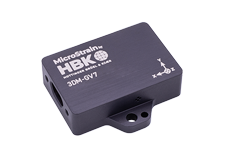FAQs
Videos
When you receive your inertial sensor, you can immediately begin operating it with our SensorConnect software.
SensorConnect is a Microsoft Windows-based out-of-the-box software utility that allows users to fully configure and operate inertial sensors, as well as store, display, and export data. Many users will be able to accomplish their use of the inertial sensor with just SensorConnect.
Click here to learn more and download SensorConnect.
SensorConnect does not guarantee full support of legacy products. Click here for a comple list of inertial products supported by SensorConnect.
MIP Monitor remains available for use with legacy products. Click here to download MIP Monitor.
If one was to attempt dead reckoning, one would follow this path:
1: The inertial sensor provides acceleration with respect to its body-fixed coordinate system. This must be transformed into a coordinate system fixed to the earth. In order to accomplish this, it is necessary to know the orientation of the inertial sensor relative to the earth-fixed coordinate system.
2. Subtract the gravity vector.
3. Double integrate (WRT time) the acceleration.
Note that any small errors in either the orientation estimate, or the sensor’s acceleration bias, or the knowledge of the gravity vector will result in exponentially increasing errors. The size of these errors has no bounds.
We generally do not recommend our sensors for applications involving position measurement due the exceptional difficultly of such computations.
Even the best systems, costing hundreds of thousands of dollars, are subject to error accumulation on the order of 1 kilometer per hour.
The bias errors of the industrial grade accelerometers used in the inertial sensor will produce errors of many kilometers within seconds.
This assumes that the orientation is known perfectly.
Uncertainty in the orientation measurement will make the errors even larger.
These inertial instruments use MEMS sensors (accelerometers, gyroscopes).
These MEMS sensors are classified as 'automotive' or ‘industrial’ grade.
They are not 'tactical' or 'navigational' grade.
The bottom line is that the inertial sensor cannot directly provide a displacement measurement.
Let us also be very clear that this statement is not meant to dissuade you; it is meant to set the tone for the complexity involved in this application.
Papers such as this discuss the science involved in great detail: https://www.google.com/url?sa=t&rct=j&q=&esrc=s&source=web&cd=1&ved=0ahUKEwiCsraTjO3RAhWj24MKHXIvBIAQFggaMAA&url=https%3A%2F%2Fsciforum.net%2Fconference%2Fecsa-1%2Fpaper%2F2395%2Fdownload%2Fpdf&usg=AFQjCNEqcxQZFt3dmpiyKJOTzcNXiwgnzA&cad=rja[na01.safelinks.protection.outlook.com]
Vibration impacts MEMS-based inertial sensors; this is true for our inertial sensors or any other manufacturers.
Every effort must be made to eliminate vibration.
Vibration in the environment frame can significantly degrade the performance of the inertial sensor, particularly constant, unchanging vibration.
Strong, continuous vibrations appear as unaccounted noise to the filter, degrading its performance.
The accelerometers can't tell the difference between vibration and acceleration, and therefore the filter receives erroneous input.
We would suggest using some vibration damping materials to mount the inertial sensor.
Here are some product manufacturers:
· http://www.earsc.com/
· http://www.sorbothane.com/
Here is an on-line source for ordering small quantities, small squares of material: http://www.mcmaster.com/#ultra-soft-polyurethane/=gai91i
The idea is to place the pad between the vehicle frame and the inertial sensor to isolate the inertial sensor.
There are many ways to physically accomplish this damping.
As an example, you could mount the inertial sensor on the aluminum plate and place a Sorbothane pad between the plate and the vehicle frame.
Sorbothane can be purchased with double-sided adhesive.
Be careful not to defeat the isolation by using through-bolts that transfer the vehicle frame vibration to the inertial sensor (or in this example, the aluminum plate holding it).










